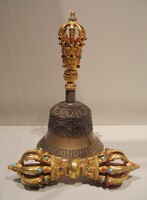Vajra Scepter Page - Updated

Vajra Scepter (Tibetan: dor je. English: the best stone): [1] from the Vedic literature, the scepter of the Hindu god Indra namely a lightening bolt, [2] from the Puranic literature, a weapon made from the bones of a rishi, and [3] a word that is used to represent Tantric Buddhism - Vajrayana. As a Buddhist scepter it is a small object made of metal generally having five or nine prongs at each end that bend inward to form a rounded enclosure. As a ritual object in Tantric Buddhism it is usually accompanied by a bell with a half vajra handle (Sanskrit: ghanta). Vajras are also found with Buddhists of South-east Asia, particularly Java, and with the Shingon Buddhists of Japan.
The nine pronged configuration is the vajra most commonly used by the Nyingma Tradition of Tibetan and Himalayan Buddhism. The five pronged configuration is the vajra used by the new schools, or Sarma Traditions: Sakya, Kagyu, Jonang, Gelug, etc.
A one pronged vajra is related to naga rituals. A vajra with five prongs having the tines or tips open and not touching the central prong is a 'wrathful' five prong vajra. Vajras with faces adorning the center are thought to be created in the Dali Kingdom of South-west China. Vajras with dragon prongs of nine or more, some over one hundred, are of Chinese origin. Vishvavajras with twenty prongs represent activity and are typically held in the hand of the deity Vajravidarana or the Buddha Amoghasiddhi.
There are many types and variations of vajras:
1. Single Pronged Vajra
2. Three Pronged Vajra
3. Five Pronged Vajra - closed tines
4. Five Pronged Vajra - open tines (wrathful)
5. Seven Prong Vajra
6. Nine Pronged Vajra
7. Twelve Pronged Vajra (vishvavajra)
8. Twenty Pronged Vajra (vishvavajra)
9. Multiple Pronged Vajra
10. Vajras with Faces (Dali Kingdom?)
11. Vajras with Dragon Prongs
12. Japanese Vajras
13. Javanese Vajras
14. Dali Kingdom Vajras
15. Jade Vajra & Bell
